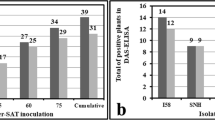Abstract
The protocol described is intended to be used alongside molecular methods in order to reveal the relationship between the genome sequence and the biological properties of a single isolate of Citrus tristeza virus complex (CTV). It enables the phenotypic profile of the isolates to be defined and to infer the associated tristeza diseases (decline, seedling yellows, or stem pitting), to assess their aggressiveness or potential cross protectiveness (if any), and to monitor their movement into the host plants and the transmissibility by aphids.
Access this chapter
Tax calculation will be finalised at checkout
Purchases are for personal use only
Similar content being viewed by others
References
Moreno P, Garnsey SM (2010) Citrus tristeza diseases-A worldwide perspective. In: Karasev AV, Hilf ME (eds) Citrus tristeza virus complex and tristeza diseases. APS Press, St. Paul, MN, pp 27–49
Dawson WO, Garnsey SM, Tatineni S et al (2013) Citrus tristeza virus–host interactions. Front Microbiol 4:88. doi: 10.3389/fmicb.2013.00088
Harper SJ, Dawson TE, Pearson MN (2010) Isolates of Citrus tristeza virus that overcome Poncirus trifoliata resistance comprise a novel strain. Arch Virol 155:471–480
Moreno P, Ambros S, Albiach-Marti MR et al (2008) Citrus tristeza virus: a pathogen that changed the course of the citrus industry. Mol Plant Pathol 9:251–268
Hilf ME, Mavrodieva VA, Garnsey SM (2005) Genetic marker analysis of a global collection of isolates of Citrus tristeza virus: characterization and distribution of CTV genotypes and association with symptoms. Phytopathology 95:909–917
Garnsey SM, Civerolo EL, Gumpf DJ et al (2005) Biological characterization of an international collection of Citrus tristeza virus (CTV) isolates. In: Hilf ME, Duran-Vila N, Rocha-Peña MA (eds) Proceedings of the 16th Conference of the International Organization of Citrus Virology IOCV, Riverside, CA, pp 75–93
Roy A, Brlansky RH (2009) Population dynamics of a Florida Citrus tristeza virus isolate and aphid-transmitted subisolates: identification of three genotypic groups and recombinants after aphid transmission. Phytopathology 99:1297–1306
Harper SJ (2013) Citrus tristeza virus: evolution of complex and varied genotypic groups. Front Microbiol 4:93. doi: 10.3389/fmicb.2013.00093
Varveri C, Olmos A, Pina JA et al (2014) Biological and molecular characterisation of a distinct Citrus tristeza virus isolate originated from a lemon tree in Greece. Plant Pathol 64:792–798
Rubio L, Ayllon MA, Kong P et al (2001) Genetic variation of Citrus tristeza virus isolates from California and Spain, evidence for mixed infections and recombination. J Virol 75:8054–8062
Permar TA, Garnsey SM, Gumpf DJ et al (1990) A monoclonal antibody that discriminates strains of Citrus tristeza virus. Phytopathology 80:224–228
Bar-Joseph M, Batuman O, Roistacher C (2010) The history of Citrus tristeza virus—Revisited. In: Karasev AV, Hilf ME (eds) Citrus tristeza virus complex and tristeza diseases. APS Press, St. Paul, MN, pp 3–26
Wang JB, Bozan O, Kwon SJ et al (2013) Past and future of a century old Citrus tristeza virus collection: a California citrus germplasm tale. Front Microbiol 4:366. doi: 10.3389/fmicb.2013.00366
Sambade A, Rubio L, Garnsey SM et al (2002) Comparison of viral RNA populations of pathogenically distinct isolates of Citrus tristeza virus: application to monitoring cross-protection. Plant Pathol 51:257–265
Licciardello G, Raspagliesi D, Bar Joseph M et al (2012) Characterization of isolates of Citrus tristeza virus by sequential analyses of enzyme immunoassays and capillary electrophoresis-single-strand conformation polymorphisms. J Virol Methods 181:139–147
Licciardello G, Scuderi G, Ferraro R et al (2015) Deep sequencing and analysis of small-RNAs in sweet orange grafted on sour orange infected with two Citrus tristeza virus isolates prevalent in Sicily. Arch Virol 160:2583–2589
Nauer EM, Roistacher CM, Labanauskas CK (1967) Effects of mix composition, fertilization, and pH on citrus growing in UC-type potting mixtures under greenhouse conditions. Hilgardia 38:557–567
Nauer EM, Roistacher CM, Labanauskas CK (1968) Growing citrus in modified UC potting mixture. Calif Citrogr 53:456, 458, 460–461
Roistacher CN (1991) Graft-transmissible diseases of citrus. In: Handbook for detection and diagnosis. FAO, Rome, p 286
Pina J A, Moreno P, Juarez J et al (2005) A new procedure to index Citrus tristeza virus-induced decline on sour orange rootstock. In: Proceedings of the 16th Conference of the International Organisation of Citrus Virologists IOCV, Riverside, CA, USA, 491, p.47
Garnsey S M, Muller GW (1988) Efficiency of mechanical transmission of Citrus tristeza virus. In: Timmer LW, Garnsey SM, Navarro L (eds) In: Proceedings of the 10th Conference of the International Organization of Citrus Virology IOCV, Riverside, CA, pp 46–54
Garnsey SM, Gonsalves D, Purcifull DE (1977) Mechanical transmission of Citrus tristeza virus. Phytophatology 67:965–968
Bovè JM, Vogel R (1980) Description and illustration of virus and virus like-like diseases of citrus. A collection of colours slides. I.R.F.A SETCO-FRUITS, Paris
Roistacher CN, Nauer EM (1985) Effect of supplemental light on citrus seedlings in winter. Citrograph 70:181–196
Nauer EM, Carson RC (1985) Packaging citrus seed for long-term storage. Citrograph 70:229–230
Lee RF, Keremane ML (2013) Mild strain cross protection of tristeza: a review of research to protect against decline on sour orange in Florida. Front Microbiol 4:259
Author information
Authors and Affiliations
Corresponding author
Editor information
Editors and Affiliations
Rights and permissions
Copyright information
© 2019 Springer Science+Business Media, LLC, part of Springer Nature
About this protocol
Cite this protocol
Russo, M., Catara, A.F. (2019). Phenotyping Biological Properties of CTV Isolates. In: Catara, A., Bar-Joseph, M., Licciardello, G. (eds) Citrus Tristeza Virus. Methods in Molecular Biology, vol 2015. Humana, New York, NY. https://doi.org/10.1007/978-1-4939-9558-5_3
Download citation
DOI: https://doi.org/10.1007/978-1-4939-9558-5_3
Published:
Publisher Name: Humana, New York, NY
Print ISBN: 978-1-4939-9557-8
Online ISBN: 978-1-4939-9558-5
eBook Packages: Springer Protocols




